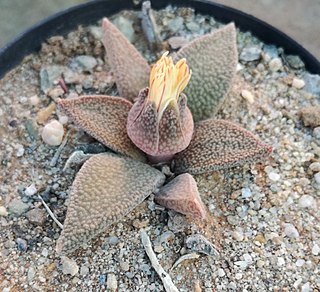
Aloinopsis is a genus of ice plants from South Africa.

In botany, succulent plants, also known as succulents, are plants with parts that are thickened, fleshy, and engorged, usually to retain water in arid climates or soil conditions. The word succulent comes from the Latin word sucus, meaning "juice" or "sap".

Curio radicans, syn. Senecio radicans, is a succulent houseplant that is native to Southern Africa. A member of the family Asteraceae, the asters, this species is closely related to the common string of pearls and Curio hallianus. It has multiple tendrils of glossy, banana-shaped foliage. It is commonly known as string of bananas or fishhook senecio.

Cheiridopsis denticulata is a species in the genus Cheiridopsis native to South Africa. It has yellow flowers, and distinctive foliage with a narrow, upward curving shape. Commonly called "pink fingers", the leaves grow in opposite pairs and are light blue with sun exposure blushing them shades of pink and purple.

Aloinopsis malherbei is a species of succulent plant, also known as the giant jewel plant. It is native to the Cape Provinces of South Africa, especially the area around Calvinia and Loeriesfontein. The plant produces a thick tuber and produces yellow flowers. Unlike other Aloinopsis, it only has tubercles (bumps) at the leaf tips.

Aloe humilis, also known as spider aloe is a species of succulent plant in the genus Aloe. It is endemic to South Africa's Cape Province, and is a low growing, short stemmed aloe with small spines and which grows in dense clusters.

Cheiridopsis pillansii is a species of plant in the genus Cheiridopsis native to South Africa. It is a low-growing succulent with pairs of small, cushion-like leaves that are pale green to purple in color. C. pillansii, sometimes commonly called the "hoof mesemb", forms clumps up to 500 millimetres (20 in) wide.

Haworthia mutica is a species of succulent plant native to South Africa's Cape Province. Very similar to, and often confused with, types such as Haworthia retusa, the species has blunt, triangular shaped leaves that are typically striated. In the wild it rarely offsets, though clones in cultivation may do so readily. The variety H. mutica var nigra is similar but with darker leaf color.

Haworthia chloracantha is a species of succulent plant native to the Cape Province of South Africa. H. chloracantha has typically pale yellow-green leaves and is somewhat similar to Haworthia reticulata in form, but the leaves are opaque rather than translucent. It forms prolific clusters of plants. The plant has a few subvarieties including var. denticulifera, meaning has small teeth on its leaves, and var. subglauca, which has darker foliage.

Haworthia lockwoodii is a species of succulent plant in the genus Haworthia. Native to the Cape Province of South Africa, it was named for a local magistrate.

Haworthia floribunda is a species of succulent plant in the genus Haworthia native to the Cape Province of South Africa. It grows in rosettes with dark green, lanceolate leaves that curve or twist outward. The leaves may be smooth or, in H. floribunda var. dentata, have small teeth.

Haworthia herbacea is a species of succulent plant in the genus Haworthia native to the Cape Province of South Africa. Closely related to Haworthia reticulata, it has greenish yellow leaves with small spines. As it matures the leaves get darker green and the white spots raise. Flowers by way of a shoot and produces a large off-white flower.

Crassula spathulata is a creeping, succulent ground-cover, indigenous to the Eastern Cape Province of South Africa, where it is found in leaf-litter on rocky ridges, often around the edges of forests.

Cheiridopsis peculiaris is a species of succulent plant in the genus Cheiridopsis native to South Africa. Its name refers to the peculiar leaf shape compared to other species in its genus. Like other Cheiridopsis it has leaf pairs, but unusually the outer pair grows flat along the ground while the other pair faces toward the sky.

Aloinopsis luckhoffii is a species of succulent plant in the genus Aloinopsis native to South Africa. Like other Aloinopsis it grows in a rosette of leaves close to the ground. It has angular leaves that are covered by small, white tooth-like protrusions.

Aloinopsis rubrolineata is a species of succulent plant in the genus Aloinopsis native to South Africa. It grows in a branching habit low to the ground, and has leaves covered with small, round tubercles. The leaves are dark olive green and tongue-like in shape. Its scientific name refers to its flowers, which have a distinctive red stripe.

Crassula ericoides is a species of succulent plant in the genus Crassula native to South Africa. Growing in the fynbos ecosystem of South Africa, C. ericoides somewhat resembles a heather, growing into an upright shrub with bare lower stems and yellow flowers at the tips.

Crassula tecta is a species of succulent plant in the genus Crassula native to South Africa. Easily confused with Crassula namaquensis, this species has a compact growth habit forming clusters of round, blue-white leaves. Kept in cultivation since the 18th century, Crassula tecta is known for the beautiful patterning on its leaves and white flowers.

Crassula namaquensis is a species of succulent plant in the genus Crassula native to South Africa. Easily confused with some forms of Crassula tecta and Crassula sericea, this species has rounded to elongated leaves that are usually blue, covered in fine hairs, and form clumps.

Dracaena hallii is a species of succulent plant native to Mozambique, Zimbabwe, and Limpopo Province of South Africa. The species was named for Harry Hall, formerly the curator of succulents at Kirstenbosch National Botanical Garden in Cape Town. Commonly known as the "baseball bat" plant, it has extremely thick foliage with a rounded shape and a central channel.




















